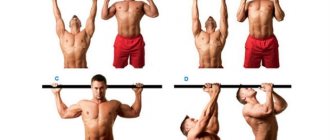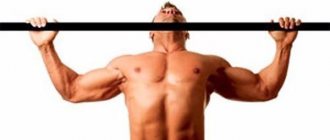Exercises with your own body weight on the horizontal bar develop the core muscles, strengthen the ligaments and tendons of the upper extremities. A novice athlete gets the opportunity to build a strong muscle frame and an athletic figure without visiting a fitness center. Today we will talk about more advanced activities. The article presents pull-up training programs for trained athletes who want to improve their results.
Hand position in pull-ups
As a rule, pull-up programs involve the use of a classic straight grip - the palms are turned away from you and slightly wider than the shoulder joints.
In fact, by changing the position of the hands on the bar, you can increase or decrease the load, as well as shift the emphasis in the exercise from one muscle group to another.
Let's briefly look at popular grip options:
- Straight . Palm position: turned away from you and slightly wider than shoulder-width apart. With this grip, the biceps brachii, forearm, delta, and latissimus muscles are evenly loaded.
- Reverse . Position of the palms: turned towards you and spaced at the width of the shoulder joints. The emphasis of the load shifts to the biceps of the arms, and the lats are additionally involved.
- Different grip . The position of the palms is: one is turned towards you, the second is turned away from you. The distance between the brushes is small. The biceps and anterior deltoids are mainly loaded.
- Narrow . Palm position: turned away from you and brought close to each other. When performing pull-ups this way, the lower lats, biceps, and anterior deltoids are worked out.
- Wide . Palm position: turned away from you and spread wide (80–100 cm). Pull-ups work the lats, biceps, and a little bit of the pecs. When pulling up behind the head, the trapezius, lats, and biceps are included.
- Parallel . Palm position: facing each other (a special horizontal bar with narrow parallel stops is used). The main load is taken by the biceps; the lats and brachialis work additionally.
The effectiveness of training on the horizontal bar can be increased by using pull-ups with different grips in one program. The torso muscles will be more fully involved, and this will allow you to quickly achieve your goals in developing an athletic physique.
Don't forget about the lower body. To develop your figure harmoniously, add various squats, lunges, deadlifts, and plyometric elements to pull-ups. Such exercises will help to form developed muscles of the legs and buttocks.
Preparatory exercises
You can prepare for a full workout on the bar with the help of special simulators that perform lat pulldowns with a wide grip. If you can't use the machine, call a friend to help. He should hold you by the waist, while your task is to pull yourself up to full amplitude. Let a friend monitor the process, give advice and correct visible errors. This is just an imitation of real pull-ups, but it gives you the skills you need to succeed on the apparatus. Such exercises train your arms to support body weight, help you perform the necessary movements, and strengthen your muscles.
Partial pull-ups
Full range of pull-ups are not an easy task. Those who cannot perform the exercise without jerking can be advised to reach as high as possible and try to hold on to the peak point for as long as possible. Constantly repeat your actions, each time it will become easier to perform them. In each lesson you need to rise as high as possible and stay as long as possible. Success comes to those who do not give up; this rule also works in mastering pull-ups.
Negative phase
To master the exercise, you can start by working in the negative phase. This means lowering into a straight arms position. To carry out such a maneuver, you need to stand on the stand located under the horizontal bar, climb up, then remove your legs and lower yourself down without jerking.
This will strengthen your muscles and increase endurance. To achieve greater results, you need to stay in the upper position for a few seconds.
Australian pull-up
A lightweight option for preparing for a full pull-up, suitable for women. During the exercise, the body is at an angle of approximately 50 degrees to the horizontal surface, the horizontal bar is located at chest level. You need to straighten your arms and pull your chest towards the apparatus.
You can also do pull-ups on a low bar so that your chin is above the horizontal bar. Another option is to work out on a Smith machine, which is available in any gym.
Bars
We take hold of the parallel bars, place our legs on the crossbar, and then pull ourselves up to the horizontal bar so as to touch it with our chest.
We fix the body in this position and return to the starting position. An important point is that your back should be straight.
Pull-ups using a harness
This simple adaptation to the horizontal bar can make the task of mastering pull-ups easier.
They need to be secured to the horizontal bar, and the knees should be placed in the loop formed at the bottom. The rubber band will take on part of the load and help you learn how to pull yourself up.
Programs to increase the number of repetitions
30 week training plan
Classes are held every other day, that is, 3-4 workouts per week. Rest between sets - 2 minutes. After completing 5 sets, we recommend hanging on the horizontal bar for a while. This will help strengthen your wrists and develop a strong grip. If possible, periodically change the position of your palms on the bar. This way the muscles will be worked out more fully.
| A week | 1 | 2 | 3 | 4 | 5 | 6 | 7 | 8 | 9 | 10 | 11 | 12 | 13 | 14 | 15 |
| Set 1 | 6 | 7 | 8 | 8 | 9 | 10 | 10 | 11 | 12 | 12 | 13 | 14 | 14 | 15 | 16 |
| Set 2 | 5 | 6 | 6 | 7 | 7 | 7 | 8 | 8 | 8 | 9 | 9 | 9 | 10 | 10 | 10 |
| Set 3 | 5 | 5 | 5 | 5 | 6 | 6 | 6 | 7 | 7 | 7 | 8 | 8 | 8 | 9 | 9 |
| Set 4 | 4 | 4 | 5 | 5 | 5 | 6 | 6 | 6 | 7 | 7 | 7 | 8 | 8 | 8 | 9 |
| Set 5 | 4 | 4 | 4 | 5 | 5 | 5 | 6 | 6 | 6 | 7 | 7 | 7 | 8 | 8 | 8 |
| Total | 24 | 26 | 28 | 30 | 32 | 34 | 36 | 38 | 40 | 42 | 44 | 46 | 48 | 50 | 52 |
| A week | 16 | 17 | 18 | 19 | 20 | 21 | 22 | 23 | 24 | 25 | 26 | 27 | 28 | 29 | 30 |
| Set 1 | 16 | 17 | 18 | 18 | 19 | 20 | 20 | 21 | 22 | 22 | 23 | 24 | 24 | 25 | 26 |
| Set 2 | 11 | 11 | 11 | 12 | 12 | 12 | 13 | 13 | 13 | 14 | 14 | 14 | 15 | 15 | 15 |
| Set 3 | 9 | 10 | 10 | 10 | 11 | 11 | 11 | 12 | 12 | 12 | 13 | 13 | 13 | 14 | 14 |
| Set 4 | 9 | 9 | 10 | 10 | 10 | 11 | 11 | 11 | 12 | 12 | 12 | 13 | 13 | 13 | 14 |
| Set 5 | 9 | 9 | 9 | 10 | 10 | 10 | 11 | 11 | 11 | 12 | 12 | 12 | 13 | 13 | 13 |
| Total | 54 | 56 | 58 | 60 | 62 | 64 | 66 | 68 | 70 | 72 | 74 | 76 | 78 | 80 | 82 |
Scheme for achieving 50 pull-ups on the horizontal bar
The program starts with light loads, but by the end you will be able to achieve the results typical of high-level athletes. To successfully complete the training plan, adhere to the following rules:
- Before you begin, take a physical fitness test.
- Based on the test results, select a cycle.
- Loop and test again.
- Based on the data obtained, select one of the cycles again.
- Repeat the scheme and over time you will reach the last cycle and the coveted 50 pull-ups.
Three important notes:
- The test involves performing classic pull-ups for the maximum number of repetitions while maintaining the correct exercise technique.
- Take a day break between training days. Between 3 and 4, as well as between 6 and 7 classes, rest for at least 2 days. After completing the cycle, take a break for 2-3 days.
- Rest between sets as needed. As a rule, 2–3 minutes are enough. You should have a good feeling when your muscles have recovered for the next set.
So, do a test set of maximum pull-ups and choose one of the training cycles below.
Cycle 1 (6 to 8 pull-ups):
| Day 1 | Day 2 | Day 3 | Day 4 | Day 5 | Day 6 | |
| Set 1 | 2 | 2 | 3 | 3 | 3 | 4 |
| Set 2 | 3 | 3 | 4 | 4 | 4 | 5 |
| Set 3 | 2 | 2 | 2 | 3 | 3 | 4 |
| Set 4 | 2 | 2 | 2 | 3 | 3 | 4 |
| Set 5 | 3 | 4 | 4 | 4 | 5 | 6 |
Cycle 2 (9 to 11 pull-ups):
| Day 1 | Day 2 | Day 3 | Day 4 | Day 5 | Day 6 | |
| Set 1 | 3 | 4 | 5 | 5 | 6 | 6 |
| Set 2 | 5 | 6 | 7 | 8 | 9 | 9 |
| Set 3 | 3 | 4 | 5 | 5 | 6 | 6 |
| Set 4 | 3 | 4 | 5 | 5 | 6 | 6 |
| Set 5 | 5 | 6 | 6 | 8 | 8 | 10 |
Cycle 3 (12 to 15 pull-ups):
| Day 1 | Day 2 | Day 3 | Day 4 | Day 5 | Day 6 | |
| Set 1 | 6 | 6 | 7 | 7 | 8 | 9 |
| Set 2 | 8 | 9 | 10 | 10 | 11 | 11 |
| Set 3 | 6 | 6 | 6 | 7 | 8 | 9 |
| Set 4 | 6 | 6 | 6 | 7 | 8 | 9 |
| Set 5 | 8 | 9 | 9 | 10 | 10 | 11 |
Cycle 4 (16 to 20 pull-ups):
| Day 1 | Day 2 | Day 3 | Day 4 | Day 5 | Day 6 | |
| Set 1 | 8 | 9 | 9 | 10 | 11 | 11 |
| Set 2 | 11 | 12 | 13 | 14 | 15 | 15 |
| Set 3 | 8 | 9 | 9 | 10 | 10 | 11 |
| Set 4 | 8 | 9 | 9 | 10 | 10 | 11 |
| Set 5 | 10 | 11 | 12 | 13 | 13 | 13 |
| Day 7 | Day 8 | Day 9 | |
| Set 1 | 12 | 12 | 13 |
| Set 2 | 16 | 16 | 17 |
| Set 3 | 11 | 12 | 13 |
| Set 4 | 11 | 12 | 13 |
| Set 5 | 15 | 16 | 16 |
Cycle 5 (21 to 25 pull-ups):
| Day 1 | Day 2 | Day 3 | Day 4 | Day 5 | Day 6 | |
| Set 1 | 12 | 13 | 13 | 14 | 14 | 15 |
| Set 2 | 16 | 16 | 17 | 19 | 19 | 20 |
| Set 3 | 12 | 12 | 13 | 13 | 14 | 14 |
| Set 4 | 12 | 12 | 13 | 13 | 14 | 14 |
| Set 5 | 15 | 16 | 16 | 18 | 19 | 20 |
| Day 7 | Day 8 | Day 9 | |
| Set 1 | 16 | 16 | 17 |
| Set 2 | 20 | 21 | 22 |
| Set 3 | 16 | 16 | 16 |
| Set 4 | 16 | 16 | 16 |
| Set 5 | 20 | 20 | 21 |
Cycle 6 (26 to 30 pull-ups):
| Day 1 | Day 2 | Day 3 | Day 4 | Day 5 | Day 6 | |
| Set 1 | 16 | 16 | 17 | 17 | 18 | 19 |
| Set 2 | 18 | 20 | 21 | 22 | 23 | 25 |
| Set 3 | 15 | 16 | 16 | 17 | 18 | 18 |
| Set 4 | 15 | 16 | 16 | 17 | 18 | 18 |
| Set 5 | 17 | 19 | 20 | 22 | 22 | 24 |
| Day 7 | Day 8 | Day 9 | |
| Set 1 | 19 | 19 | 20 |
| Set 2 | 26 | 27 | 28 |
| Set 3 | 18 | 19 | 20 |
| Set 4 | 18 | 19 | 20 |
| Set 5 | 25 | 26 | 28 |
Cycle 7 (31 to 35 pull-ups):
| Day 1 | Day 2 | Day 3 | Day 4 | Day 5 | Day 6 | |
| Set 1 | 20 | 22 | 23 | 24 | 25 | 25 |
| Set 2 | 25 | 25 | 26 | 27 | 28 | 29 |
| Set 3 | 19 | 21 | 23 | 24 | 24 | 25 |
| Set 4 | 19 | 21 | 23 | 24 | 24 | 25 |
| Set 5 | 23 | 25 | 25 | 26 | 27 | 28 |
| Day 7 | Day 8 | Day 9 | |
| Set 1 | 26 | 26 | 26 |
| Set 2 | 29 | 30 | 32 |
| Set 3 | 25 | 26 | 26 |
| Set 4 | 25 | 26 | 26 |
| Set 5 | 29 | 30 | 32 |
Cycle 8 (36 to 40 pull-ups):
| Day 1 | Day 2 | Day 3 | Day 4 | Day 5 | Day 6 | |
| Set 1 | 23 | 24 | 25 | 26 | 26 | 26 |
| Set 2 | 27 | 28 | 29 | 30 | 31 | 31 |
| Set 3 | 22 | 24 | 24 | 25 | 25 | 26 |
| Set 4 | 22 | 24 | 24 | 25 | 25 | 26 |
| Set 5 | 26 | 28 | 29 | 30 | 31 | 31 |
| Day 7 | Day 8 | Day 9 | |
| Set 1 | 27 | 28 | 28 |
| Set 2 | 31 | 32 | 34 |
| Set 3 | 26 | 26 | 27 |
| Set 4 | 26 | 26 | 27 |
| Set 5 | 32 | 32 | 34 |
Cycle 9 (more than 40 pull-ups):
| Day 1 | Day 2 | Day 3 | Day 4 | Day 5 | Day 6 | |
| Set 1 | 25 | 25 | 25 | 26 | 26 | 27 |
| Set 2 | 28 | 29 | 30 | 31 | 32 | 32 |
| Set 3 | 24 | 25 | 25 | 25 | 26 | 26 |
| Set 4 | 24 | 25 | 25 | 25 | 26 | 26 |
| Set 5 | 26 | 28 | 29 | 31 | 31 | 32 |
| Day 7 | Day 8 | Day 9 | |
| Set 1 | 27 | 28 | 29 |
| Set 2 | 34 | 34 | 35 |
| Set 3 | 26 | 26 | 27 |
| Set 4 | 26 | 26 | 27 |
| Set 5 | 33 | 34 | 35 |
Armstrong pull-up technique
Before proceeding directly to the pull-up system, it is necessary to strengthen the muscles of the shoulder girdle. To do this, every day in the morning, after waking up, perform 3 sets of classic push-ups to the maximum. Continue for 3-4 weeks.
The program consists of 5 training days. Saturday, Sunday - rest.
The effectiveness of the plan will depend on regularity. It is not recommended to skip classes. It is important to monitor the “quality” of pull-ups. It is better to do fewer repetitions, but with the correct technique.
Monday
Perform 5 sets of pull-ups on the horizontal bar for as many reps as possible. The grip is classic, straight. The pause between sets is 1.5–2 minutes.
Tuesday
Training using the “pyramid” system. Do 1 pull-up, rest 10 seconds, do 2 pull-ups, rest 20 seconds, do 3 pull-ups, rest 30 seconds.
Continue in this manner until you reach the maximum number of repetitions in the set. After this, rest for 1 minute and do one more approach to failure.
Wednesday
Experimentally determine for yourself the number of repetitions with which you can do 9 sets. Conduct a workout by changing the grip width every 3 approaches: wide, medium, narrow.
Rest between sets - 1 minute. It is important that the number of pull-ups in each set is the same.
Thursday
On the previous day, you determined the number of repetitions in the set. Now do the maximum number of approaches (preferably more than 9), changing the grip width every 3 sets. Rest - 60 seconds. Add 1 rep to your set each week.
Friday
Evaluate the 4 previous lessons and determine the most difficult for yourself. This is exactly what you will do on this day.
Conclusion
Trained athletes who do 8-10 reps per set will be able to do at least 20 pull-ups after 4-5 weeks of this program. The main thing is regularity and the desire for results.
Program 25 pull-ups in 6 weeks
First of all, it is necessary to determine the initial level of training. To do this, perform the maximum number of pull-ups in 1 set while maintaining the correct technique.
- Entry level - 1 time.
- Average level - 2-3 times.
- Good level - more than 4 times.
Compare the test result with the tables of pull-ups on the horizontal bar (below) and determine your load.
Train 3 times a week. Rest at least 24 hours between workouts. Between sets, pause for 50–60 seconds (more if necessary).
The program is not suitable for athletes who do more than 8-10 pull-ups, as it will be useless for them.
First week
Monday
| Elementary | Average | Good | |
| Approach 1 | 1 | 1 | 1 |
| Approach 2 | 1 | 1 | 2 |
| Approach 3 | 1 | 1 | 2 |
| Approach 4 | — | 1 | 1 |
| Approach 5 | — | 1 | 2 |
Wednesday
| Elementary | Average | Good | |
| Approach 1 | 1 | 1 | 1 |
| Approach 2 | 1 | 1 | 2 |
| Approach 3 | 1 | 1 | 2 |
| Approach 4 | 1 | 1 | 1 |
| Approach 5 | — | 1 | 3 |
Friday
| Elementary | Average | Good | |
| Approach 1 | 1 | 1 | 2 |
| Approach 2 | 1 | 2 | 2 |
| Approach 3 | 1 | 1 | 2 |
| Approach 4 | 1 | 1 | 1 |
| Approach 5 | 1 | 2 | 3 |
Second week
Monday
| Elementary | Average | Good | |
| Approach 1 | 1 | 1 | 1 |
| Approach 2 | 1 | 2 | 2 |
| Approach 3 | 1 | 1 | 2 |
| Approach 4 | 1 | 1 | 1 |
| Approach 5 | 1 | 2 | 3 |
Wednesday
| Elementary | Average | Good | |
| Approach 1 | 1 | 2 | 3 |
| Approach 2 | 1 | 2 | 3 |
| Approach 3 | 1 | 2 | 2 |
| Approach 4 | 1 | 1 | 2 |
| Approach 5 | 1 | 2 | 3 |
Friday
| Elementary | Average | Good | |
| Approach 1 | 1 | 2 | 2 |
| Approach 2 | 1 | 2 | 3 |
| Approach 3 | 1 | 2 | 3 |
| Approach 4 | 1 | 2 | 3 |
| Approach 5 | 1 | 2 | 3 |
Third week
Monday
| Elementary | Average | Good | |
| Approach 1 | 2 | 2 | 2 |
| Approach 2 | 2 | 3 | 3 |
| Approach 3 | 1 | 2 | 3 |
| Approach 4 | 1 | 2 | 3 |
| Approach 5 | 2 | 3 | 3 |
Wednesday
| Elementary | Average | Good | |
| Approach 1 | 2 | 3 | 3 |
| Approach 2 | 2 | 4 | 4 |
| Approach 3 | 2 | 3 | 4 |
| Approach 4 | 2 | 3 | 4 |
| Approach 5 | 3 | 4 | 4 |
Friday
| Elementary | Average | Good | |
| Approach 1 | 2 | 3 | 4 |
| Approach 2 | 2 | 4 | 5 |
| Approach 3 | 2 | 3 | 4 |
| Approach 4 | 2 | 3 | 4 |
| Approach 5 | 2 | 4 | 5 |
Fourth week
Monday
| Elementary | Average | Good | |
| Approach 1 | 2 | 3 | 4 |
| Approach 2 | 2 | 4 | 5 |
| Approach 3 | 2 | 3 | 4 |
| Approach 4 | 2 | 3 | 4 |
| Approach 5 | 3 | 4 | 6 |
Wednesday
| Elementary | Average | Good | |
| Approach 1 | 2 | 4 | 5 |
| Approach 2 | 3 | 5 | 6 |
| Approach 3 | 2 | 4 | 5 |
| Approach 4 | 2 | 4 | 5 |
| Approach 5 | 3 | 5 | 7 |
Friday
| Elementary | Average | Good | |
| Approach 1 | 3 | 4 | 6 |
| Approach 2 | 3 | 5 | 6 |
| Approach 3 | 2 | 5 | 5 |
| Approach 4 | 2 | 5 | 5 |
| Approach 5 | 4 | 6 | 7 |
Fifth week
Monday
| Elementary | Average | Good | |
| Approach 1 | 3 | 5 | 6 |
| Approach 2 | 4 | 6 | 7 |
| Approach 3 | 3 | 4 | 5 |
| Approach 4 | 3 | 4 | 5 |
| Approach 5 | 3 | 6 | 7 |
Wednesday
| Elementary | Average | Good | |
| Approach 1 | 3 | 5 | 7 |
| Approach 2 | 4 | 7 | 8 |
| Approach 3 | 4 | 4 | 6 |
| Approach 4 | 3 | 4 | 5 |
| Approach 5 | 4 | 7 | 8 |
Friday
| Elementary | Average | Good | |
| Approach 1 | 4 | 6 | 8 |
| Approach 2 | 4 | 7 | 8 |
| Approach 3 | 4 | 5 | 6 |
| Approach 4 | 3 | 4 | 6 |
| Approach 5 | 4 | 7 | 8 |
Sixth week
Monday
| Elementary | Average | Good | |
| Approach 1 | 5 | 7 | 9 |
| Approach 2 | 4 | 7 | 8 |
| Approach 3 | 4 | 5 | 6 |
| Approach 4 | 4 | 5 | 6 |
| Approach 5 | 4 | 7 | 9 |
Wednesday
| Elementary | Average | Good | |
| Approach 1 | 5 | 7 | 9 |
| Approach 2 | 5 | 7 | 9 |
| Approach 3 | 4 | 6 | 6 |
| Approach 4 | 4 | 6 | 7 |
| Approach 5 | 5 | 7 | 9 |
Friday
| Elementary | Average | Good | |
| Approach 1 | 5 | 7 | 9 |
| Approach 2 | 5 | 7 | 9 |
| Approach 3 | 5 | 7 | 8 |
| Approach 4 | 5 | 7 | 8 |
| Approach 5 | 5 | 7 | 9 |
At the end of the program, athletes at a good level should perform a test set on the horizontal bar for maximum repetitions.
If you managed to do 25 clean pull-ups while maintaining the same technique, congratulations, the result has been achieved! If it doesn’t work, repeat the week 6 program and test yourself again.
Athletes with beginner and intermediate levels need to rest for 3-4 days and go through the entire training cycle again, but with increased loads.
Is the 100 pull-up program real?
It is difficult to offer a specific program that allows you to achieve 100 pull-ups in one approach. That's a lot!
You can use the 30-week plan (discussed earlier) and achieve 82 pull-ups in 5 sets. If you need to break the 100 pull-up mark, intuitively add a few reps to each set and extend the plan over several days.
However, there are unique athletes who have achieved 100 repetitions on the horizontal bar in one set. For example, Andrey Isypov (Andrey’s VK page).
The journey from 40 to 100 pull-ups took him more than two years. Andrey's program consists of endurance classes and training on the horizontal bar with additional weight. In this interview, the athlete talks about his technique.
Program 10 pull-ups
A simple training plan for athletes who do 4-6 pull-ups but want to increase their reps to 10 per set.
Classes are held every other day: Monday, Wednesday, Friday. (Saturday, Sunday - days off). Rest between sets - 1-2 minutes. The program lasts 2 weeks.
| Mon. | SR. | PT. | Mon. | SR. | PT | |
| Set 1 | 2 | 2 | 3 | 3 | 3 | 4 |
| Set 2 | 3 | 3 | 4 | 4 | 5 | 5 |
| Set 3 | 2 | 2 | 2 | 3 | 3 | 4 |
| Set 4 | 2 | 2 | 2 | 3 | 3 | 4 |
| Set 5 | 3 | 4 | 4 | 4 | 5 | 6 |
| Total | 12 | 13 | 15 | 17 | 19 | 23 |
After completing the program, do a test approach. Typically, all athletes using this plan perform 10 or more repetitions. If it doesn’t work, rest for a week and repeat the scheme.
It is possible if you follow the training rules:
You need to show will. If you start practicing, then decide for yourself that there is no going back, only forward - to results.
Discipline. Being your own coach is not easy. And even more so with a demanding and harsh coach. You need to not only force yourself to do this or that exercise, but also figure out why something might not work out.
Regularity. The main secret of how to do a lot of pull-ups is regular exercise.
Know how. You can train using the method of countless attempts, or you can act on the recommendations of those who already know how to do more pull-ups, who no longer consider 40 pull-ups per set to be unrealistic.
Programs for strength, mass, relief
Pull-up program with weights
This training plan is designed for athletes who can freely do 12-15 pull-ups. The goals are to develop strength and build muscle mass. Number of classes - 3 per week. Rest between sets - 2-3 minutes. The program lasts 8 weeks.
| weeks | 1 (5 kg) | 2 (6 kg) | 3 (7 kg) | 4 (8 kg) | 5 (9 kg) | 6 (10 kg) | 7 (12 kg) | 8 (14 kg) |
| Set 1 | 7 | 8 | 8 | 9 | 9 | 10 | 10 | 11 |
| Set 2 | 6 | 7 | 8 | 8 | 9 | 9 | 10 | 10 |
| Set 3 | 5 | 6 | 6 | 7 | 7 | 8 | 9 | 10 |
| Set 4 | 6 | 7 | 8 | 8 | 9 | 9 | 10 | 10 |
| Total | 24 | 28 | 30 | 32 | 34 | 36 | 39 | 41 |
The weight loads of the projectiles attached to the belt are indicated in brackets. If you can’t use the suggested weights, you can slightly reduce the weight, but the number of repetitions should remain the same.
Training program on the horizontal bar and uneven bars
The program is designed for advanced athletes. Number of classes - 3-4 per week. Rest between sets - 1-2 minutes. The method of conducting the lesson is circular. Number of laps - 2-3 per workout:
- Joint warm-up.
- Pull-ups with a straight grip - 10-12 times.
- Push-ups from parallel bars - 10-12 times.
- Bulgarian squats - 15 times on each leg.
- Reverse grip pull-ups - 10-12 times.
- Reverse push-ups from the bench - 10-12 times.
- Air squats - 20 times.
- Pull-ups with a narrow grip - 10-12 times.
- Push-ups from the floor - 10-12 times.
- Jumping up from a deep squat - 30 times.
On rest days, additional cardio exercises are allowed. This will help you burn subcutaneous fat faster. The main thing is to monitor your well-being, recover well and avoid overtraining.
1-arm pull-up program with rubber loops
The training plan is designed for experienced athletes. The program is based on the use of rubber expander loops of different hardness. Pull-ups are performed alternately with both hands.
First 4-5 workouts:
- Joint warm-up.
- 10 sets of one-arm pull-ups using a green loop resistance band. Quantity - in each approach to failure. Rest between sets - 5 minutes.
Second 4–5 workouts:
- Joint warm-up.
- 6 sets of 10 pull-ups to the waist with 2-3 minutes rest between sets.
- 10 sets of one-arm pull-ups using a green loop resistance band. Quantity - in each approach to failure. Rest between sets - 5 minutes.
Third 4–5 workouts:
- Joint warm-up.
- 6 sets of 12 pull-ups to the waist with 2-3 minutes rest between sets.
- 10 sets of one-arm pull-ups using a green loop resistance band. Quantity - in each approach to failure. Rest between sets - 5 minutes.
Fourth 4–5 workouts:
- Joint warm-up.
- 5 sets of 12 pull-ups to the waist with 2-3 minutes rest between sets.
- 10 sets of one-arm pull-ups using a green loop resistance band. Quantity - in each approach to failure. Rest between sets - 4 minutes.
Fifth series of 4–5 workouts:
- Joint warm-up.
- 5 sets of 12 pull-ups to the waist with 2-3 minutes rest between sets.
- 10 sets of one-arm pull-ups using a purple loop resistance band. Quantity - in each approach to failure. Rest between sets - 4 minutes.
- 5 sets of classic pull-ups to failure. Rest - 2-3 minutes.
Sixth series of 4–5 workouts:
- Joint warm-up.
- 5 sets of 12 pull-ups to the waist with 2-3 minutes rest between sets.
- 10 sets of one-arm pull-ups using a yellow loop resistance band. Quantity - in each approach to failure. Rest between sets - 4 minutes.
- 5 sets of classic pull-ups to failure. Rest - 2-3 minutes.
Pull yourself up.
If you want to be good at pull-ups, do more pull-ups. Sounds too simple to be effective, doesn't it?
Many people want to find some “magic” exercise that will allow them to do better pull-ups, but it doesn’t work that way.
Here's the thing: People often do lat pulldowns (a machine that mimics the movement of a pull-up) thinking it will improve their pull-up skills. But this won't happen. You need something really worthwhile.
I understand that some of you are only able to do one good pull-up. So be it - but do one pull-up several times. Spreading these small sets in your routine - one pull-up between sets of various other exercises in your workout program for the day - is a good way to improve it.
Aim for 25-50 strict pull-ups three times a week (25 if you're a beginner). If you don't go to the gym, set up a pull-up bar at home and do a couple of pull-ups every time you pass by.
If you can already do five pull-ups, do as many sets of two or three reps as you need, without being shy about your maximum, until you reach 50 pull-ups in one workout.
The point is in quantity—by counting complete repetitions, the number will increase over time.
Pull-up techniques
In addition to the presented programs, there are intensive training methods on the horizontal bar, which can be periodically used to “shock” the muscles and overcome the plateau state:
- Ladder . The athlete increases the number of pull-ups by one with each subsequent set until he reaches the maximum value. Rest - 30–40 seconds.
- Reverse ladder . The athlete does a set to failure, rests for about 30–40 seconds, then does another set to failure. The exercise is performed until the number of failure repetitions drops to a minimum.
- Pull-ups every hour during the day . The athlete does one approach every hour. It is recommended to start at 10:00, and the last set should be completed at 20:00. If you do 6 repetitions every hour, then for the whole day you will get a rather impressive number - 66 pull-ups.
It is possible if you follow the training rules:
You need to show will. If you start practicing, then decide for yourself that there is no going back, only forward - to results.
Discipline. Being your own coach is not easy. And even more so with a demanding and harsh coach. You need to not only force yourself to do this or that exercise, but also figure out why something might not work out.
Regularity. The main secret of how to do a lot of pull-ups is regular exercise.
Know how. You can train using the method of countless attempts, or you can act on the recommendations of those who already know how to do more pull-ups, who no longer consider 40 pull-ups per set to be unrealistic.
Are separate pull-up programs needed for girls?
There are usually no separate programs for girls. Athletes can use any plan presented in the article.
Of course, before starting the program, the girl needs to master the movement itself on the horizontal bar. To do this, we suggest that you familiarize yourself with the following materials:
- Negative pull-ups in training.
- Pull-ups on the horizontal bar from scratch.
If it is difficult for a beginner athlete to lift her body weight on the bar, we recommend doing pull-ups in a gravitron or using expander loops.
Pull-ups to get the GTO badge
Pull-up chart for boys and men (high bar):
| Steps (by age) | Bronze badge | Silver badge | Gold badge |
| 1 tbsp. (6–8 years) | 2 | 3 | 4 |
| 2 tbsp. (9–10 years) | 2 | 3 | 5 |
| 3 tbsp. (11–12 years old) | 3 | 4 | 7 |
| 4 tbsp. (13–15 years old) | 4 | 6 | 10 |
| 5 tbsp. (16–17 years old) | 8 | 10 | 13 |
| 6 tbsp. (18–24 years old) | 9 | 10 | 13 |
| 6 tbsp. (25–29 years old) | 9 | 10 | 12 |
| 7 tbsp. (30–34 years old) | 4 | 6 | 9 |
| 7 tbsp. (35–39 years old) | 4 | 5 | 8 |
| 8 tbsp. (40–44 years old) | 4 | 6 | 9 |
| 8 tbsp. (45–49 years old) | 3 | 5 | 8 |
| 9 tbsp. (50–54 years old) | 2 | 4 | 7 |
| 9 tbsp. (55–59 years old) | 2 | 3 | 6 |
Pull-up chart for girls and women (low bar):
| Steps (by age) | Bronze badge | Silver badge | Gold badge |
| 1 tbsp. (6–8 years) | 4 | 6 | 11 |
| 2 tbsp. (9–10 years) | 7 | 9 | 15 |
| 3 tbsp. (11–12 years old) | 9 | 11 | 17 |
| 4 tbsp. (13–15 years old) | 10 | 12 | 18 |
| 5 tbsp. (16–17 years old) | 11 | 13 | 19 |
| 6 tbsp. (18–24 years old) | 10 | 12 | 18 |
| 6 tbsp. (25–29 years old) | 9 | 11 | 17 |
| 7 tbsp. (30–34 years old) | 8 | 10 | 26 |
| 7 tbsp. (35–39 years old) | 7 | 9 | 15 |
| 8 tbsp. (40–44 years old) | 6 | 8 | 14 |
| 8 tbsp. (45–49 years old) | 5 | 7 | 12 |
| 9 tbsp. (50–54 years old) | 4 | 6 | 10 |
| 9 tbsp. (55–59 years old) | 3 | 5 | 9 |
Depending on what badge you are applying for, you can use the training plans presented in this article or other programs for beginners.
You can find preparation recommendations here and here.
Choice of weights
Weights are used by athletes who have confidently mastered the technique, can consistently do more than 10 pull-ups per approach, and want to speed up their training to gain muscle mass. Additional devices increase your own body weight, increase the load
In this case, it is important that the center of gravity does not shift, that no swaying or pendulum effect occurs; the body must maintain a vertical position when lifting. The following are used as weights:
- a backpack that holds water bottles, sandbags, or other heavy items;
- a belt to which a cable or chain with a load is attached so that in a standing position the weight is between the legs;
- a vest, over the area of which inserts for filler bags with sand are evenly placed.
They start by determining the maximum weight with which it is possible to perform one high-quality lift. The further scheme of pull-ups is built depending on the purpose of the training. For strength, do 2-4 repetitions with weights of 85-90% of the maximum, with long rests between sets. For muscle growth, use a weight of 70-80% and do 10-12 repetitions. Endurance training occurs with 15–20 cycles with a weight of 50–70% of the maximum weight. Increased load requires a good warm-up before starting class and adherence to technique.
Vest
Backpack
Belt with weight
Which program is better?
The choice of program depends on many factors. For example, an athlete who does 5-7 pull-ups should not start strength training on a horizontal bar with weights. First, he needs to increase the number of pull-ups to at least 10–15.
The genetic characteristics of an athlete are of great importance. Some people have better developed ligaments and tendons, while others have less developed ones. Consequently, training methods and results will be different. In this material we have presented various programs - choose the appropriate training plan. We wish you successful training!











